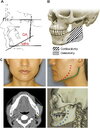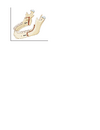Changing the gonial angle, the angle between the jawbone and the base of the mandible, typically involves orthognathic surgery, specifically mandibular angle osteotomy or sagittal split osteotomy. These procedures reshape the jawbone to alter the angle for aesthetic or functional reasons.
Surgical Procedures:
Mandibular Angle Osteotomy:
This involves cutting and repositioning the bony angle of the mandible to create a more defined or softened jawline.

Sagittal Split Osteotomy:
This technique separates the jawbone into two segments and allows for repositioning to change the gonial angle and correct malocclusions.

Other Considerations:
Masseter Muscle Resection:
In some cases, the size of the masseter muscle can also influence the appearance of the gonial angle. Reducing the muscle can help to create a more refined jawline.

HA-fibrin sculpting:
This non-surgical technique can be used to enhance the gonial angle in specific cases, particularly when posterior augmentation is needed.
Natural Changes:
Gonial angle can naturally change with age, potentially leading to an increase in the angle.
Dental Health:
Loss of teeth can also affect the gonial angle, so maintaining good dental health is important.
Surgical Procedures:
Mandibular Angle Osteotomy:
This involves cutting and repositioning the bony angle of the mandible to create a more defined or softened jawline.

Sagittal Split Osteotomy:
This technique separates the jawbone into two segments and allows for repositioning to change the gonial angle and correct malocclusions.

Other Considerations:
Masseter Muscle Resection:
In some cases, the size of the masseter muscle can also influence the appearance of the gonial angle. Reducing the muscle can help to create a more refined jawline.

HA-fibrin sculpting:
This non-surgical technique can be used to enhance the gonial angle in specific cases, particularly when posterior augmentation is needed.
Natural Changes:
Gonial angle can naturally change with age, potentially leading to an increase in the angle.
Dental Health:
Loss of teeth can also affect the gonial angle, so maintaining good dental health is important.

